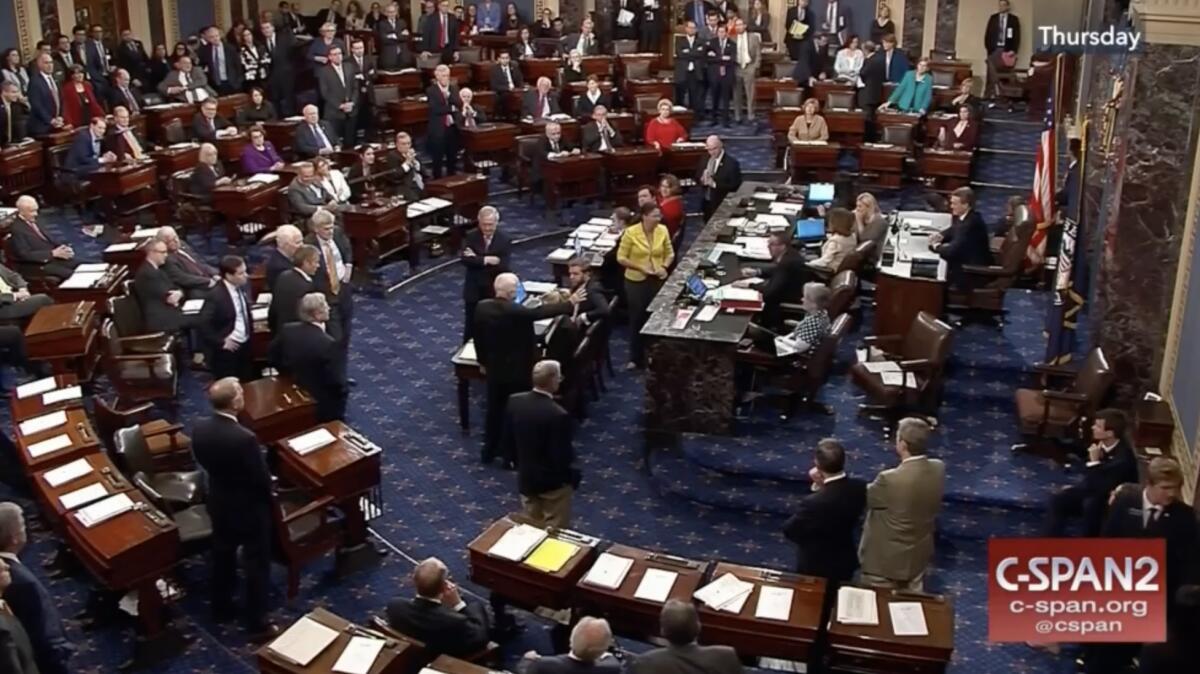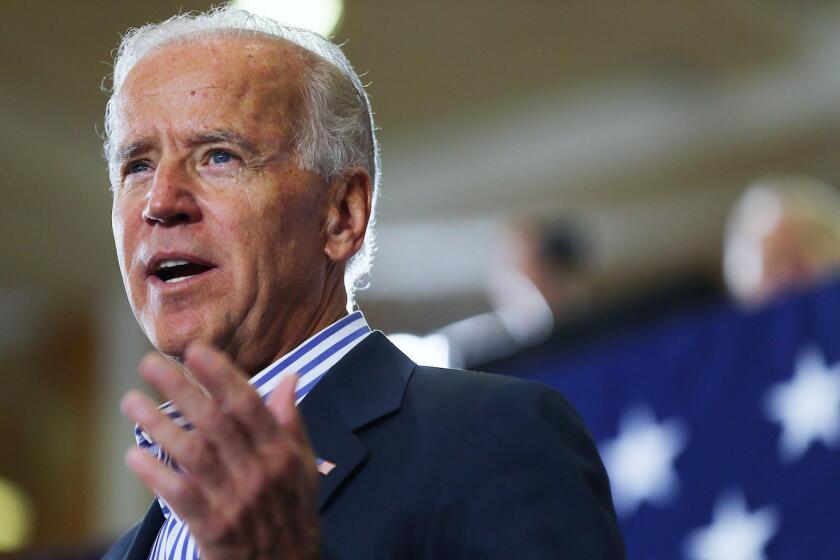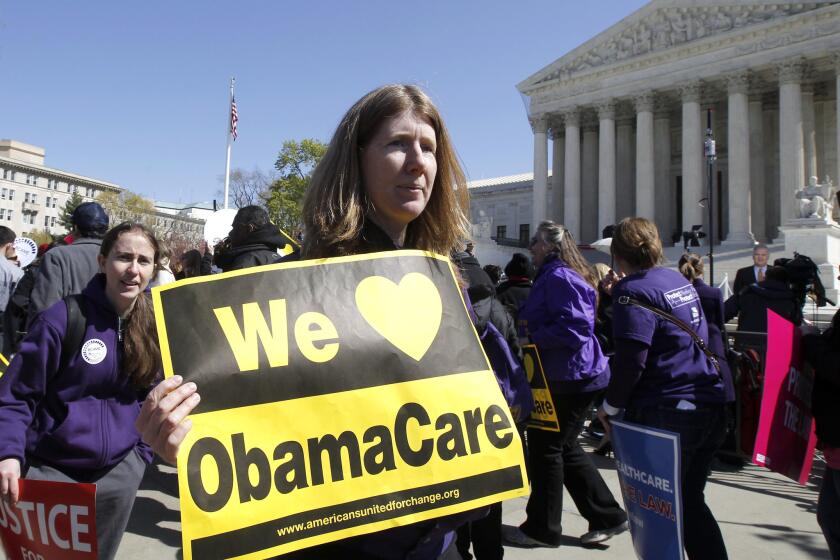Column: Jonathan Cohn’s history of Obamacare shows how our political system is broken

It was a moment of high drama in the brief life of the Affordable Care Act, the signal achievement of President Obama’s two terms. Shortly after midnight on July 28, 2017, Sen. John McCain (R-Ariz.) strode to the Senate floor and placed himself before the clerk’s podium to cast his vote on a Republican measure to repeal the law.
The GOP-controlled House already had voted its assent, and the Senate vote was the last step in the ACA’s extinction.
McCain outstretched his arm, spread his fingers, and abruptly brought them into a fist with his thumb pointing down. Obamacare repeal was dead.
The veteran healthcare reporter Jonathan Cohn begins and ends his new history of the ACA, “The Ten Year War,” with this doughty gesture by McCain only 13 months before his death from brain cancer. It’s a useful signifier of how close the landmark healthcare measure has come to repeal in the years since its enactment in 2010.
The book’s title, however, is a bit of a misnomer, because Cohn has more to cover than merely a single decade.
Cohn carries the story of America’s effort to remake its healthcare system into something more humane, efficient and serviceable back to President Franklin Roosevelt’s unfulfilled dream to make healthcare reform part of the New Deal.
He continues through the Clinton administration’s stillborn 1993 effort, and looks ahead to the campaign by reformers for a healthcare system that serves everyone in America. Not for nothing is his book subtitled “Obamacare and the Unfinished Crusade for Universal Coverage.”
Get the latest from Michael Hiltzik
Commentary on economics and more from a Pulitzer Prize winner.
You may occasionally receive promotional content from the Los Angeles Times.
“The policy arguments for ‘Medicare for all’ or something close to it have only gotten stronger,” Cohn told me from his home in Ann Arbor, Mich.
Notwithstanding the ACA’s consumer protections and subsidies, “we see lots of people who are still struggling with medical costs, because so many people have policies in which the copays and deductibles are huge and premiums are just too high.”
Nevertheless, he says, “My guess is that the political obstacles are as substantial as ever.”
Cohn established his bona fides as an expert in the American healthcare system with his 2007 book “Sick: The Untold Story of America’s Health Care Crisis — And the People Who Pay the Price.” He now follows healthcare policy for HuffPost.
Democrats slipped massive Obamacare improvements into the new pandemic rescue bill.
Cohn is adept at identifying the factors that make healthcare reform a uniquely difficult problem for the American political system.
Start with the fact that a small proportion of the population accounts for the great majority of medical expenses: The rule that 20% of people account for 80% of costs, he writes, is “as fundamental to health economics as E=mc2 is to physics.”
This unappreciated reality has vast significance for healthcare reform. It implies, for example, that most people won’t have a complicated interaction with the healthcare system through most of their lives.
For those whose most serious medical crises fall within the category of cases that the system can handle routinely — a broken limb, pregnancy, even a cardiac event — the current system of health insurance, in which 49% of Americans receive coverage through their employers, is good enough.
It’s on the margins where the system’s inadequacies appear. But when they do, the consequences for the victims are enormous.
“A lot of people with really, really lousy health insurance didn’t know it because they never had to use it,” Cohn says. “If they did get a tragic healthcare problem — a car accident, or cancer, or a child with a congenital problem — for the first time they have to use their health insurance and now they’re discovering what it doesn’t cover.”
That creates both “a sense of complacency and a resistance to change, and then when you do make the change it can strengthen the backlash.”
The Supreme Court debated Obamacare’s technicalities, but the healthcare of all Americans hangs in the balance.
Perhaps the most common complaint heard when the ACA marketplace was first introduced for the 2014 plan year was “sticker shock.” Consumers in the individual market started being charged more — sometimes much more — for insurance they had seldom used.
Cohn says that in all his years of covering the healthcare market as a reporter, “I spent so much time writing about people who thought they had good insurance until they got sick and realized their policies were terrible,” that he didn’t appreciate how customers would react to higher premiums.
“To me it was obvious that even if you were paying more for your insurance you were so much better protected that of course that was a worthwhile trade. I knew that because I covered healthcare, but all that most people would know was that their premiums went up 50% and they were happy with what they had before.”
The sheer complexity of the healthcare system widened the gulf between the Democrats’ and Republicans’ approach to the issue.
“If you’re a liberal, you feel that everybody has certain vulnerabilities, and as a society it’s in our interest to protect people at their moments of vulnerability and to do so by chipping in as part of a common enterprise,” he says.
(That’s a good way to define a progressive tradition dating back to Franklin Roosevelt, who spoke of Social Security as a program that would provide Americans with “security against the hazards and vicissitudes of life.”)
The reality of healthcare policy, Cohn says, is that “you just can’t solve the problem if the government doesn’t get heavily involved. You’re not going to get a lot of people healthcare without a lot of government spending and government intervention in the economy. Those are things that liberals and Democrats are comfortable with and Republicans are not, so they’re going to instantly be skeptical.”
Cohn uses the process that produced the Affordable Care Act to illuminate the fundamental flaws of the congressional legislative framework.
California’s Obamacare exchange will have minimal rate increases next year, despite COVID
Even after the outlines of the act were established, a painful period of horse-trading ensued.
“People looking back ask why does the Affordable Care Act look like it does — why isn’t it better?” he says. “I wanted to write the book because collective memory had already faded about how difficult it had been, and I wanted to show people that it was far more difficult than they even realized.”
The fate of the act turned on dozens of minor, seemingly technical issues that never got much press, but were cherished by legislators who wanted either to make sure that one provision or another was in the bill, or some others were cut out. These were layered on top of big issues such as the bill’s treatment of abortion.
“Every one of these had to be accommodated,” he says. “Legislation is always like that, but it was particularly hard in this case” because the Democrats’ margin to overcome the threat of a Senate filibuster was so thin that they could not afford to lose a single senator’s vote.
Needing 60 votes and having 60 votes “gives every single senator a veto — if you have to make 60 people happy enough to vote for this thing, as the process goes forward it gets scarier.”
While it’s true that no legislation affecting one-sixth of the U.S. economy can, or should, be easy, “I don’t think it had to be this hard.”
That points to the institutional barriers in American government to getting change done, Cohn suggests. The Senate has a structural bias that favors rural populations and conservatives. The filibuster raises the prospect of legislators representing a small minority of the U.S. population holding broadly popular legislation hostage.
Throw in the power of money — and the incumbent interests in healthcare such as insurers, drug companies, hospitals and doctors themselves have all the money they need to make their voices heard — and “it becomes almost impossible to pass anything.”
That spotlights the strategic skills of House Speaker Nancy Pelosi (D-San Francisco) and then-Senate Majority Leader Harry Reid (D-Nev.) in shepherding the Affordable Care Act through to passage.
Biden reverses Trump’s widely ridiculed claim that the Affordable Care Act is unconstitutional.
But it explains why features that would have made the ACA better for everyone, such as a public option to compete with private health insurers and the allocation of more money for premium subsidies, never made it to the finish line.
It also explains the legislative song-and-dance that preceded passage of the $1.9-trillion pandemic relief bill, the American Rescue Plan, signed by President Biden on Thursday.
Among the last-minute changes in the measure was a reduction of weekly unemployment benefits to $300 from the originally proposed $400 and a tightening of eligibility for $1,400 stimulus checks based on income. These were reportedly insisted on by Sen. Joe Manchin (D-W.Va.), who exercised his prerogative as a must-have Democratic vote.
The act did, however, take steps toward fixing shortcomings of the ACA that remained in place because of a decade of GOP obstructionism. Among them is a long-sought enhancement of premium subsidies to cover almost all Americans rather than being capped at households earning 400% of the federal poverty line.
Cohn sees the ACA as one of a series of steps that will eventually bring America to the goal of universal health coverage. Whether the system becomes Medicare for all in Vermont Sen. Bernie Sanders’ vision — specifically using the nation’s healthcare system for older people as a model for everyone — or as a metaphor isn’t as important as reaching the ultimate goal.
Cohn observes that countries that have achieved universal coverage have done so through many different models, but that “the high-functioning systems we see overseas all operate by the same set of principles: Everyone has coverage as a right of citizenship. The government has some kind of overall control over spending, whether through a global budget or regulating prices or both, and while there may be out-of-pocket costs they’re nothing like what we have in this country.
“To me,” he says, “that’s the ideal.”











